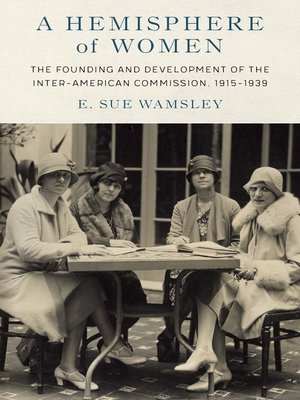A Hemisphere of Women
ebook ∣ The Founding and Development of the Inter-American Commission, 1915–1939
By E. Sue Wamsley

Sign up to save your library
With an OverDrive account, you can save your favorite libraries for at-a-glance information about availability. Find out more about OverDrive accounts.
Find this title in Libby, the library reading app by OverDrive.



Search for a digital library with this title
Title found at these libraries:
| Library Name | Distance |
|---|---|
| Loading... |
Though the first decades of the twentieth century witnessed extensive U.S. intervention in Latin American affairs, the United States started to back away from overtly flexing its military muscle to gain power and control, instead using a type of "soft power" more in tune with the spirit of cooperation and collaboration. This new policy, often viewed as female attributes of Pan Americanism, opened the door for women to gain a foothold on the inter-American stage. In the late nineteenth and early twentieth centuries, these Pan American women's movements emerged with the founding of a variety of international organizations that began a worldwide campaign to improve women's lives.
In A Hemisphere of Women E. Sue Wamsley analyzes the history of the Inter-American Commission of Women: the first all-female, government-affiliated body to deal specifically with women's civil and political rights in a transnational arena. She examines how women who had semi-official government roles worked within a neocolonial, male-dominated diplomatic setting to bring about change. U.S. women assumed that they would be the "natural" leaders, stereotyping their Latin American colleagues as unsophisticated and inexperienced. Party members quickly learned, however, that they had underestimated their Latin American sisters, who also had ideas about women's rights and how the campaign should be run.
Utilizing the policy of "soft power," the women, with the help of Latin American officials, managed to work around cultural differences and define common goals rooted in the advancement of women's civil and political rights, giving hemispheric women a recognized position in shaping transnational gender law. Wamsley's innovative analysis at once addresses a void in scholarship and interweaves the history of Pan Americanism, foreign relations, and imperialism with that of women.
In A Hemisphere of Women E. Sue Wamsley analyzes the history of the Inter-American Commission of Women: the first all-female, government-affiliated body to deal specifically with women's civil and political rights in a transnational arena. She examines how women who had semi-official government roles worked within a neocolonial, male-dominated diplomatic setting to bring about change. U.S. women assumed that they would be the "natural" leaders, stereotyping their Latin American colleagues as unsophisticated and inexperienced. Party members quickly learned, however, that they had underestimated their Latin American sisters, who also had ideas about women's rights and how the campaign should be run.
Utilizing the policy of "soft power," the women, with the help of Latin American officials, managed to work around cultural differences and define common goals rooted in the advancement of women's civil and political rights, giving hemispheric women a recognized position in shaping transnational gender law. Wamsley's innovative analysis at once addresses a void in scholarship and interweaves the history of Pan Americanism, foreign relations, and imperialism with that of women.







